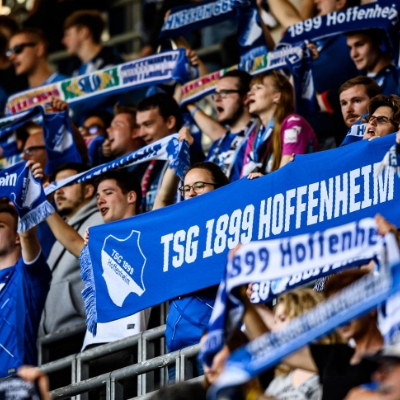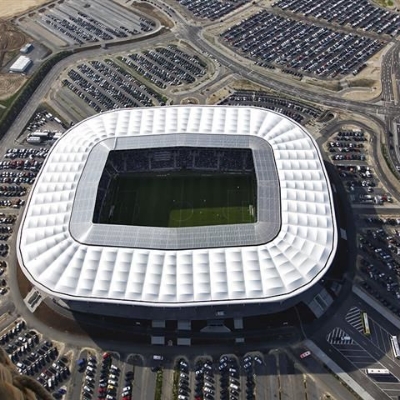One game, 3,600,000 data points
A few years ago, a revolution took place in German football that initially went almost unnoticed. This was primarily due to the fact that the innovations were not visible on the pitch. It was not about tactical innovations such as the back-three or immediately obvious changes such as the inclusion of the backpass rule. The start of the new era began off the pitch – on the roofs of the arenas, to be precise. Since then, the technology and processes have been constantly improved to systematically record every movement on the pitch. In the 2017/18 season, the newly founded company Sportec Solutions, a subsidiary of the DFL, took over the mandate for the collection, storage, quality assurance and delivery of the official game data of the DFL. Starting in the 2019/20 season, the number of cameras for positioning data acquisition in all Bundesliga stadiums has been increased even further to a maximum of 20.
Since then, the ball and players can no longer escape the gaze of the digital eyes. At the end of each game, there are now around 3.6 million data points available, which all add up to provide interesting and entertaining facts and are not only of interest to fans and media: the club's data analysts also use the findings for their live analysis. Dr. Hendrik Weber, managing director of Sportec Solutions, emphasises: "Game data is not a magic potion, but it is a tool that can no longer be neglected." In January 2020, the tool went through another stage of development: The Bundesliga was the first league in the world to seal a collaboration with Amazon Web Services (AWS), which, thanks to new tools such as machine learning and artificial Intelligence (AI), enabled further innovations such as the speed alarm, expected goals (xGoals) and the in-game formation and tactics being used.
Speed alarm
Since Matchday 5 this season, the Bundesliga has been providing its fans with a new live service: while the game is being transmitted, the speed alarm is triggered when a player registers a personal best, the top speed on a team, in the match, for the season or even the top speed of all time. This is possible because the position of each player and the ball is recorded 25 times per second, so data such as the players' speeds can be calculated. With the support of the DFL's partner AWS, these values can be compared with all historical data very quickly.
In-game formation
This technology can also identify the "in-game formation" of each team, which was made available in the Bundesliga in May. The tactical formation shown before kick-off is compared with the average positions of the players in real time. Thus, it is easy for the viewers to see how offensively or defensively a team are playing, on which side the team is forced to do more defending and whether they are attacking more through the middle or down the wings.
Expected goals (xGoals)
Since Matchday 28 of last season, TV viewers have been able to see the goal-scoring probability for each chance. In addition, according to the DFL, the technology allows "statements about the efficiency of the individual players and teams when it comes to scoring goals, by combining the combined goal probabilities to form the expected goals (xGoals) value. Expected goals are calculated in real time after each shot, so viewers have information about the difficulty of the shot and the probability of a goal." But that's not all – the calculation uses "a lot of information from the tracking of the positioning data, including the distance and angle to the goal, the speed at which the player shooting is moving, the number of opponents between the ball and the goal and the goal coverage by the goalkeeper". The probabilities are based on historical data of more than 47,000 shots.
Humans give the machines a helping hand
Behind the revealing and entertaining stats available, each of which are only used for a few seconds during the live broadcasts, are state-of-the-art technical equipment and highly alert staff. While the data obtained is converted into figures and statistics by software, despite the impressive level of digitalization, exact data can only be determined with a human touch. Four employees per game feed the data into the programs in each stadium and assess any situations that cannot be deciphered by artificial intelligence (AI): who got to the ball first, who won the duel?
In order to instantly break down these scenes live and also feed the data obtained by the human eye into the system, a so-called "speaker" sits in the stadium, which communicates with the "writer" via a code language, which enters the data into the system in real time. Two operators synchronise the recorded events with the motion picture signals and the games are then even awarded a certified seal of approval by Sportec Solutions. The company announced in November that it will now increasingly offer its expertise to international leagues, clubs and media houses in order to "assume a leading role internationally".
Added value for all, as DFL managing director Christian Seifert points out: "In the game data segment, in particular, the possibilities for use in sports and media analysis will continue to develop rapidly. As the innovation leaders in these fields, the DFL and Sportec Solutions are providing new impetus here."
1,600 game event data points per game
Live data collection distinguishes between event data and positioning data. The first category includes, for example, duels, fouls, goals or passes to a teammate. The analysts obtain around 1,600 event data points per game. In addition, the positioning data, which can also be determined thanks to the latest technology, includes distance covered, sprints, possession of the ball or fields of activity (heat maps) of individual players. Event and positioning data are core elements of the official game data published by the DFL for each game, which includes master data such as player names, game information data such as kick-off times and line-ups, as well as basic data on the head-to-head record for the respective games. The DFL is proud to offer "the basis for all clubs to better understand their own team, their opponents and the game." Dr. Hendrik Weber, managing director of Sportec Solutions, is convinced of the added value of data analysis: "At the end of the day, this will increase the overall standard."
TSG use live data during games
The data collected by the DFL can be accessed by the media and clubs even during the match – and thus are a great help for the analysts at the clubs. Is a player sprinting less than usual? Is another one running significantly more and needs to be substituted earlier? Is the back four too high or too deep? On all these questions, the acquired live data provide clear answers and important information for clubs' game analysts, scouting departments and fitness coaches. Timo Gross, match analyst at TSG Hoffenheim, is pleased with the additional input: "The DFL provides us with a variety of data points that we can use and that help us a lot. Together with the video clips, this really adds value. Although certainly not all facets of the game are covered yet, the development is considerable and is also driven forward by regular feedback from the clubs. For example, crosses have recently been added as game events."
However, Gross doesn't want to get carried away with the usefulness of the data: "You have to combine them [the data] with the appropriate context to get really valid statements and help with the complexity of the game of football. The xGoals stats are a good example. It is an attempt to measure the expected goals and thus to help explain how the game went. The calculation involves criteria such as distance and angle to the goal, as well as the speed of the person taking the shot and the pressure on him.
Parameters such as the position of the player relative to the ball and the exact position of the goalkeeper are not yet included and at the same time show the potential for an even more comprehensive explanation." Nevertheless, the overall conclusion is entirely positive: "A much greater depth of detail and a link to the match plan are needed to be able to use the data and make them more valuable and beneficial. Our empirical values and subjective observations receive enormous support from the objective data. As a result, detailed and consistent data use in our procedures is now absolutely indispensable. But you won't be able to have a computer coach a team in future." Big Data is a big help, but it has its limits.





















